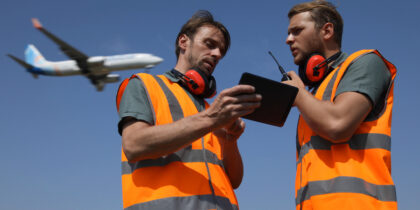Since 1959, the aviation industry and its longstanding practices have guided more than 660 million flights through more than one billion flight hours. In recent years, the industry has been more open to innovation by adopting new technologies. These advancements harness the power of new digital tools to enhance safety and increase efficiency.
The main catalyst of innovation has been the widespread adoption of the electronic flight bag (EFB). EFB is a digital system for storing and displaying aviation data that was previously printed on paper and housed in large, heavy binders that pilots carried in flight bags (thus the name). EFBs often take the form of tablets, and unlike paper records, updates are instant.
The Many Benefits of EFBs
Guidelines for the use of EFBs have been available since 2002, but EFBs weren’t widespread until the proliferation of tablet computers and the electronic flight bag software solutions that power them. EFBs save airlines a good sum of money in fuel and printing costs each year, now that pilots no longer have to print paper records or carry a 50-pound flight bag full of paper onto every flight. Everything they’re required to have on-hand is now on their mobile devices.
Flight crews also get quicker updates to manuals, charts and other key information, in addition to better tracking compliance with airline and government rules and requirements. Finally, flight crews can instantly share critical information, including unsafe runway conditions, aeronautical hazards and incidents arising from novel or unique circumstances.
Although EFBs are now common on flight decks across the United States, they represent only the first steps toward greater digital innovation in the aviation industry. Airlines that have enjoyed the benefits of EFBs are now looking to integrate more digital and mobile solutions into their operations. The increased use of technology will yield better data, which will, in turn, lead to better decision-making and more safe, on-time flights.
Innovative companies such as Comply365 have partnered with Samsung to develop workflow mobility and compliance management solutions for the aviation industry. With all the positive effects brought about by EFBs, it’s hard to imagine that other aspects of the aviation industry couldn’t benefit from greater digital innovation.
Airline Dispatchers
Dispatch releases are the legal contracts between airline dispatchers and pilots, containing specific flight information and weather forecasts. The release itself can be over 40 pages long — a huge drag on efficiency and portability. Some airlines are working toward electronic dispatch releases, which would allow for quicker transmission of releases, instant changes and electronic archives. These electronic releases would also provide a mechanism for compliance tracking, change reporting and on-time departure tracking. Based on the cost of paper for a large airline, the savings from this step could exceed $1 million a year.
Flight Attendants
Airlines are eager to expand the power of mobility beyond the flight deck, and many are beginning to introduce flight attendant programs that are similar to the EFB. The passenger cabin is the greatest revenue producer for an airline, but there’s almost no data coming from the back of the aircraft. When combined with onboard sales programs, cabin-based mobile devices can deliver a powerful tool for flight attendants to file reports, complete training and provide a better passenger experience.
Ground Crews and Customer Service Agents
Real-time communication between customer service agents and ground crews is essential, and traditional methods are imperfect. Gate agents are always on the move, rushing from gate to gate, and baggage handlers operate inside and outside, meaning they face environmental obstacles such as weather and noise. Many airlines use radios for communications, but those pose their own challenges: messages can be garbled, and every transmission is broadcast for anyone within earshot to hear.
Airlines should look to wearable devices for a more secure and reliable solution. For example, a tug driver who’s negotiating icy ramps, whining jet engines and changing plans wouldn’t need to rely on hearing a critical radio call. Instead, he could check a small wearable device for updates while on the go.
Today, all airline employees are mobile. They need to carry the right technology that will help them do their jobs better. Adding the right technology has the potential to enhance airline safety and efficiency as well as increase job satisfaction for every member of the team. Airline employees are some of the most highly trained, dedicated and professional people you will ever meet. Forward-thinking airlines should rush to provide better systems to their valued team members.
Are self-piloted planes the next step in aviation technology? Learn how this new technology could mean big changes for the aviation world.







